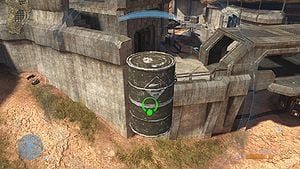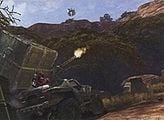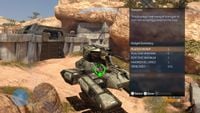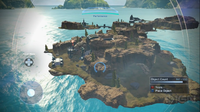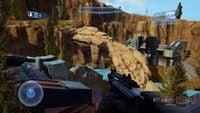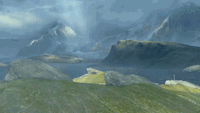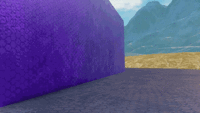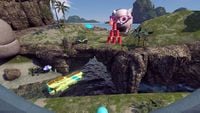Forge
From Halopedia, the Halo wiki
"WE'VE GOT A NEW CONTACT, UNKNOWN CLASSIFICATION!" This article may contain information based upon upcoming, unreleased, or recently-released content, and may not be fully complete. Additionally, the information may be subject to change if it is based on pre-release material. Please update it as soon as any relevant and accurate material is available.
|
Forge is a gameplay mode in Halo 3, Halo: Reach, Halo 4, Halo 2: Anniversary, and Halo 5: Guardians that allows for both playing and editing multiplayer maps.[1][2]
Background
Forge is a game mode originally released in Halo 3 designed to allow players to customize, save and share maps for custom games. Forge was originally created to be used by players to make relatively simple changes to maps in order to tweak their gameplay experience. Maps altered in Forge are referred to as map variants, and possible alterations include the modification of player spawn points, gametype objective points, weapon, vehicle and the addition of scenery items such as crates, fusion coils, gravity lifts, teleporters, and various other items. The amount of time and dedication spent by players in Forge mode led to the release of two Forge-specific maps, Foundry, which was released in the Heroic Map Pack, and Sandbox, which was released in the Mythic Map Pack. The scenery and layouts of these maps are almost entirely composed of movable and removable Forge objects.
In addition to functioning as map editor, Forge is also a gameplay space. Up to eight players can be on a given map at a time, shifting back and forth between their chosen multiplayer model (Player Mode) and the Edit Mode model (a Monitor) by pressing Up on the D-Pad. A variety of Forge-specific settings can be altered by the party leader while in the Forge Lobby. As an example, players in Edit Mode can be granted more (or less) health and shielding as well as varying levels of Active Camouflage — editors can even be granted near or total invulnerability. There is also a setting that, if enabled, prevents all but the party leader from entering Edit Mode. Players can play actual games in Forge, experiment with Forge's features, kill each other, play diverse and varying 'honor rules' games, and do other things that aren't accepted in regular multiplayer.
Halo 3 Forge
The tools in Forge in Halo 3 proved to be very primitive in terms of allowing players to edit maps. This is because Forge was created originally to allow players to make smaller changes to maps; Bungie did not expect such complex maps to be created with the tools they provided.
Object manipulation
In addition to modifying object spawn locations, Forge can also be used to change the properties of individual objects as well as different types of objects. Pressing X over an item allows a player in Edit Mode to alter that item's settings. Pressing X again allows players to view the settings for all objects of that type. Per-type settings can also be accessed by highlighting the given object's entry in the spawn menus, and then pressing X. An individual object (e.g., a single Gravity Lift) may have its Respawn Rate (which determines how often it spawns) and its Place at Start settings altered. Types of objects (e.g., all Gravity Lifts) may have their Run-Time Minimum and Run-Time Maximum settings altered, which allows mapmakers to ensure that there is always less than or more than a certain amount of a given item during gameplay.
Restrictions
There are some limits when placing items in Forge. The most obvious limit is the set of items permitted in a map—specific items are only allowed in specific maps. As an example, Hornets and Scorpions cannot be placed in The Pit, and Deployable Covers may not be placed in Sandtrap. (The technical explanation is that the tags for certain objects are only present in certain maps. Bungie likely did not place them for balance issues.) There are also varying limits on how many of each item can be placed; while the player can usually place up to thirty-two Frag Grenades, the player can only place two Scorpions when they are available on a map.
The amount of items the player can place in Forge is also regulated by an economy budget system.[3] Different objects are assigned to different values. This is to keep the player from overloading maps and using excessive amounts of memory. Deleting items that are already on the map will free up more money for other items. The spending limit is merely a counter to help the player gauge how much they can place on the map at a given time; no real currency is used. The highest encountered budget is located on the map Sandtrap, with a grand total of 10,000 credits. However using the budget glitch, the player can go beyond the limit set, to do this make the run time maximum one more than the current amount placed on map.[4] or they can download canvases with the budget glitch already in.
All maps have a maximum limit of 640 items.[5] The 640-item limit behaves somewhat oddly; removing items that are in the map by default does not free up more of the 640 "slots", so when editing large maps like Sandbox, it is best to move all default items to the side instead of deleting them and trying to replace them when they need them later.
Furthermore, Campaign objects, enemies, friendlies and “bots” cannot be added to map variants, and the basic geometry of the map cannot be altered.[6]
Forge filters
- Main article: Forge Filters
Forge Filters, referred to in-game as FX, are objects listed in scenery which came in the Legendary Map Pack maps, Cold Storage, and the Mythic Map Pack that change the camera settings. All the filters are as follows:
- Juicy - Everything is bright, vivid and colorful. Saturation is increased.
- Colorblind - Everything is displayed in grayscale.
- Gloomy - Everything is dark, shady, and somewhat desaturated.
- Nova - Everything is extremely bright and blurry, though really dark shadows look quite sharp.
- Old Timey - Everything looks like an old Western movie—the contents of the screen are displayed in sepia tones and are even given a flickering effect, making the screen resemble an old film projector.
- Ink - Scenes are displayed as if they were drawn using an inkpen. Bright areas tend to look more like a grayscale version of the Nova filter.
Bungie has stated that the filters were added for better experiences in gameplay, making interesting screenshots, and for making machinima. The Juicy filter helps with seeing through the Energy Blockers, as does the Old Timey filter. Should more than one of these filters be spawned at one time, the effects will merge to create an entirely new effect. Combining all of the effects reduces visibility to the point where it is improbable to see.
Halo: Reach Forge
Forge mode returns in Halo: Reach as Forge 2.0, with a variety of updated tools to allow players to more easily edit maps, and of course with a Forge palette which has been updated to include items from the Halo: Reach sandbox. A map designed for players to create their own Forge map variants named Forge World is shipped with the game.[7]
Object manipulation
Object manipulation in Forge 2.0 has been vastly improved.
- Players have the ability to select the physics of an object: normal, fixed or phased. Normal physics makes an object fall to the ground and interact with the world normally as it does in Halo 3. Fixed physics allows players to place an object and have it stay exactly where it was placed - even floating in the air. Phased physics is similar to fixed, but allows players to intersect objects with other objects or map geometry.
- Players can label most objects, giving the ability to make any part on a map only spawn during a particular game type and allowing more control over player spawning and objectives.
- When an object is being held by a player, that player now "orbits" around the object in their grasp rather than having the object "orbit" around themselves (the camera moves around the object rather than the object around the camera).
- Players can alter the color of some structures and Vehicles to indicate team color.
- Players have the ability to "nudge" pieces, and the ability to edit an object's coordinates.
Restrictions
Though Forge 2.0 is vastly improved over Classic Forge, there are still a few restrictions on what a player may do to edit a map.
- The Forge budget returns to Halo: Reach, albeit vastly bigger.
- The limit of number of a particular items placeable in Forge mode returns, albeit with some changes. The limit now applies to categories of items; for instance number of walls now applies to walls as a category, with 50 wall objects placable rather than 25 single walls and 25 double walls.
- Forge cannot be used to Forge Firefight or Campaign maps.
- Most items in Forge cost around 10 credits, while large and complex items cost more.
Forge filters
Some forge filters are limited to Forge 2.0 only. Below is a list of them.
- Colorblind - Available in Classic and Forge 2.0. It makes the map appear in grayscale.
- Next Gen - Available in Forge 2.0 and Classic as Gloomy. It makes the environment have slightly darker colors.
- Juicy - Available in Classic and Forge 2.0. Makes the environment look more vivid, as it increases saturation.
- Nova - Available in Classic and Forge 2.0. Makes the environment look really bright and blurry.Hence the name.
- Olde Timey - Available in Classic and Forge 2.0. Olde Timey makes the entire map appear to be an old movie.
- Pen and Ink - Available in Classic and Forge 2.0. Turns the environment to look as if it was drawn with an ink pen.
- Purple - Available in Forge 2.0 only. It turns the environment purple, thus giving the effect of night.
- Green - Available in Forge 2.0 only. It turns the environment green. Useful for Infection game types, as it makes the environment look scarier.
- Orange - Available in Forge 2.0 only. It turns the environment orange, thus giving the effect of a sunset or a desert-savanna effect.
Forge save glitches
Glitch 1: Occasionally and seemingly randomly, one or more of a player's custom maps will fail to save, even when the in-game message "Save Succeeded" pops up after saving a map. Because of this, when the player selects a new map to forge on, the previous map will be, in essence, deleted.
Glitch 2: Occasionally and seemingly randomly, any number of a player's custom maps will be put under another custom map's name, and the original title(s) of the moved map(s) will house a different map(s) (not necessarily a map title that the original map/maps is/are now under). This "shuffling" of maps may result in one or more maps disappearing.
Avoidance
To avoid being a victim of the Forge Save Glitches, it is advisable for players to:
- Choose "Save As New Map" rather than "Save" when saving a freshly-changed map.
- Without selecting a new map in the Forge or Custom Game lobbies, play a custom game; this will ensure that the map is put into a player's Temporary History, and can be accessed from there if the map does get "deleted".
- Upload maps to their Fileshare; if a map is deleted, it can be downloaded from the Fileshare, thereby salvaging the map.
Halo 4 Forge
Forge returns in Halo 4 as Forge 3.0, an improvement from its previous iteration in Halo: Reach. The duplication tool has returned from Halo 3, and selected objects now glow a certain color depending on what type of object is selected for better precision. The feature now supports dynamic lighting on Forge objects, enabling each individual pieces to cast shadows. It features additional tools for user for map-making such as the ability to link Forge objects seamlessly through the use of the magnet utility and adding trait zones (such as enhanced movement and gravity). Objects can be locked, preventing being grabbed/moved. More Forge objects have been added to the sandbox to provide variety to the map-making experience.[8] Infinity ordnance will be a customizable feature.[9] Halo 4 features four different Forge maps: Erosion, Impact, Ravine and Forge Island. Each map features a different environment and unique palette elements.[10]
Halo 2: Anniversary Forge
Halo 2: Anniversary features a Forge mode, Forge 4.0, though only in the reimagined multiplayer component. The new Forge features several bug fixes, including menu polishing and adding magnet location consistency. Precision control and zoom have also been added. New features include "Snap to Ground", "Align to Ground", and "Movement Snap". Tool settings are now stored between Forge sessions. The Forge "Structure" palette is now cleaner and smoother, along with new mirrored versions of objects. Additional natural and terrain structure pieces—including cliffs and large pieces of land—have also been added to the Structure palette.[11] Three Skybox-only maps—Awash, Nebula, and Skyward—have been added, allowing players to create maps and structures without interference from previous existing structures.[12][13]
The new Forge budget is now based on the amount of objects in a map. The budget can essentially be replaced by a "Performance Meter", presumably determining how well the map will run given the amount of objects placed.[11] In an official demonstration, the developers showcased a map containing a remake of Beaver Creek within a much larger Forged landscape, built completely on a flat canvas using the new terrain pieces. "Simple scripting objects" have been added as Forge objects; these allow players to create interactive systems including switches that can be used to perform various tasks, including opening doors, spawning vehicles or terrain objects, or triggering explosions.[13] There have also been Gadget improvements and new Gadgets.[11]
All seven of the Halo 2: Anniversary remastered maps feature dynamic features that alter gameplay, such as falling stalactites and breakable glass roofs on Lockdown. These features can be disabled to Forge if the players wish to have a gameplay experience that is closer to the original Halo 2.[11]
Halo 5: Guardians Forge
Halo 5: Guardians features Forge 5.0, an even more advanced form of Forge than Halo 2: Anniversary. It was released as a free feature on December 16 2015 and it will also be given new features and content on a regular basis. Forging is available for any Arena, Breakout and Big Team Battle maps, as well as the seven blank canvas maps Alpine, Barrens, Depths, Glacier, Parallax, Tidal and Breakout Arena.[14]
Among the improved features are the control scheme, selecting and manipulating up to 64 objects at once, a free camera, and smart magnets.[14] Objects are no longer constrained to certain maps, as was the case in previous games. Up to 1700+ objects can be spawned into the map and new types have been added. Terrain objects are designed to seamlessly blend into the prebuilt terrain. Objects can be grouped with a single button press and "welded" to a parent object, allowing the objects to physically move around together. Almost any object can be scripted to move, change colors, spawn, and etc.[14]
The budget system has been improved, including a multi-budget system, where a terrain piece will only eat into the memory budget once. Additional pieces only use up the object count because the shared texture is already loaded.[14] Other budgets are considered "soft" and can be exceeded, but doing so causes glitches.[14]
New light objects have been added with tons of different properties. Light fixtures such as light posts, beacon lights and etc. have been introduced. Lighting is no longer generated automatically when switching to player mode. A button tap will drop the Spartan, while holding it down will render the lighting before dropping.[14] Props like the D79-TC Pelican were added in Hammer Storm and can be customized with colors. Weather effects including rain, snow, embers, floating papers, dust, and motes were added with Ghosts of Meridian. Sound options ranging from chanting Covenant crowds to waterfalls are also available for sur.
Halo 5: Forge is a port of the Forge mode to Windows 10. It is available for free and enables players to forge, test, and share their own maps on PC, with compatibility with Halo 5: Guardians on Xbox One.[15]
 This section needs expansion. You can help Halopedia by expanding it.
This section needs expansion. You can help Halopedia by expanding it.
Trivia
| This section does not meet the wiki's general standards and/or standards on layouts. You can help by cleaning this section. |
- If the player fires their weapon and then immediately enters Edit Mode, upon returning to Player Mode, they may find that they have lost no ammo.
- If the player catches on fire (from a Firebomb Grenade or the Flamethrower) and then enters Edit Mode, they will take no damage. Upon returning to Player Mode, however, they will find that the fire was "preserved", they will once again take damage.
- The same trick can be used to delay the detonation of a grenade when they have been stuck. They can even delay the throwing of a grenade by entering Edit Mode immediately after pressing LT.
- It also applies to any momentum that the player gathered while in Player Mode, if they jump into a Grav Lift or man cannon, enter Edit Mode, move away, and then return to Player Mode, they will fly through the air. This was changed in Halo: Reach as changing to edit mode arrests the players motion; despite this, motion is sometimes preserved anyways. However, if someone in Edit mode is moving when they return to Player mode, their velocity is carried over, and can result in dying if the change happens when flying fast, as Halo: Reach physics causes damage to players if they hit any object while moving too fast.
- In Halo 4's forge, momentum is not preserved upon exiting edit mode.
- The Elephant cannot be spawned by editors due to its size, potential for lag, and specific purpose on Sandtrap, however more can be modded into the map.
- Created map variants can be saved and shared with the community. Also, if the players creation is extremely liked by Bungie, they may even add it to matchmaking.
- It is possible to do a glitch that can make a player have no weapon.
- The idea of Forge was taken from Marathon: Infinity, which also has a map editor named Forge. However, there are multiple differences: Marathon's Forge was a separate application, acting as a 'pure' map editor in conjunction with another application, Anvil, which edited physics, sounds and shapes files. On the other hand, Halo 3's Forge is merely a separate game mode that allows for the spawning and repositioning of objects.
- Forge bears resemblances to Sapien, a program in the Halo Custom Edition Editing Kit.
- Some weapons may be purchased at no cost if they were originally on the map and are not deleted. However this will leave the player with a penalty making it so that they need to sell the same amount they have spent under zero to reach zero again and make money again.
- Even when Edit Mode was restricted to "Party Leader Only", a programming mistake allowed other players to enter Edit Mode through the start menu. (Patched)
- If the player stacks both Elephants on top of each other and then put as many large objects (tanks) as they can on top the bottom, the Elephants will have reverse gravity.
- Through a glitch, it is possible to wield weapons while in Edit Mode.[16]
- During lag or a glitch, it is possible to see the small blueish-white tear drop shaped orbs (item spawn points) that denote where an object has been placed while in Player Mode. When this happens, the spawn points can be interacted with while in Player Mode. If the player shoots or melees them, they will hear the same sound that plays when shooting or beating a shield door.
- When the player is in Edit Mode, the reticule in the center of the screen appears to be the Marathon symbol. This is probably due to the fact that the eye of the Monitors resemble the same symbol.
- When in Edit Mode, the player can kill someone with a floating object and will get the Splatter Kill medal. If the player does this on a Mythic map, the player will earn the Tank Dropper achievement.
- There is a mistake when editing options in forge, it says: View current options. Only the party leader may change options, regardless of whether or not that person is the party leader.
- It is unknown why the player cannot place certain weapons on certain maps, but it is probably due to balancing. Vehicles would be unable to evade Missile Pods in indoor maps, and large vehicles like Wraiths and Scorpions might not even fit inside of indoor maps with small doors or rooms. However, weapons such as Fuel Rod Guns and Flamethrowers have limited use due network and performance issues.
- Forge 2.0 in Halo: Reach was originally going to feature Weather as a changeable object but was cut due to time restraints: "No weather effects in the Forge. Was something we wanted, but something we didn't get to in time." [17]
- The Forge 2.0 monitor makes a small noise when boosting.
- In Halo: Reach, after a player goes in to Monitor mode, the Monitor will have a shield/health HUD similar to that of the species which it was transformed from. However, if a player dies while in Monitor mode, when he/she respawns(as a monitor), it will have a Monitor HUD from Halo 3, showing only the shield bar. Exiting then reentering monitor mode after this will give a normal Spartan/Elite HUD.
- In Forge 2.0, if there is lag during a forge session and a player goes into Edit Mode, a Focus Rifle icon will appear for a second and disappear and the reticule will go from Focus Rifle reticule to edit reticule and if your pressing the fire button, the player will emit a short Focus Rifle blast with sound effect for as long as the Focus Rifle reticule is visible. Only that player will see and hear the Focus Rifle blast.
- The Halo: Reach player spawn point object features a holographic Spartan crouching with an M6G pistol aimed forward. The Spartan has a specific armor permutation that includes a variation of the Mark V[B] helmet with UA that was exclusive to Halo: Reach Beta, Mark V right shoulder, CQC left shoulder, Tactical/Tacpad wrist attachment, Tactical/Trauma Kit utility on the right thigh, and FJ/PARA knee guards.
- The initial spawn points in Halo 4 use the same Spartan hologram model as the initial spawn holograms previously used in Halo: Reach.
- Coincidentally, Halo 5: Guardians features Forge 5.0, even though the first Forge was in Halo 3. (Halo 3 had Forge 1.0, Halo: Reach featured Forge 2.0, Halo 4 featured Forge 3.0, Halo 2: Anniversary featured Forge 4.0, and Halo 5: Guardians features Forge 5.0.)
Gallery
- 1225328365 Forge monitor.jpg
A Forge Monitor in Halo 3.
Crates and an M12 Warthog LRV on Forge.
- Halo Reach Forge Concept.jpg
Concept art of a Forge game in Halo: Reach.
- H4forgemap.jpg
A Forge creation in Halo 4.
- Halo 4 Forge Monitor.jpg
A Forge Monitor in Halo 4.
Beaver Creek recreated in Halo 2: Anniversary's Forge.
Features introduced into Forge with Warzone Firefight.
Sources
- ^ Bungie.net: Bungie Weekly Update: 8/17/07
- ^ Bungie.net: Halo 3 How-to: Forge Basics
- ^ Bungie.net: Halo 3 How-to: Forge Object Editing
- ^ ForgeHub: Forging 101: Ultimate Budget Glitch
- ^ Bungie.net: Sandbox Toolkit
- ^ Bungie.net: Bungie Weekly Update: 8/22/08
- ^ IGN.com: Halo: Reach Xbox 360 Preview - Forge Video Preview
- ^ YouTube: Halo 4 Forge Demo at RTX [HD] [1080p]
- ^ Halo Waypoint: The Halo Bulletin: 7.6.12.
- ^ Examiner.com Final Halo 4 Forge map goes spelunking, holds Griffball arena in video
- ^ a b c d GameInformer: 343 Details Halo 2’s Many Changes And Additions
- ^ Twitter: Halo
- ^ a b 'IGN.com - See Forge in Halo 2: Anniversary
- ^ a b c d e f Halo Waypoint: Building the Biggest Forge Yet
- ^ Halo Waypoint: Forging Ahead - The Forge Experience Comes to Windows 10
- ^ YouTube: Halo 3 Weapon Forge Glitch (YouTube Tutorial)
- ^ Halo.Bungie.Org: Reach Forge World Q and A: Ferrex, July 22, 2010
